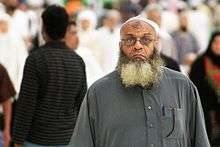Prayer bump
A zebibah (Arabic: زبيبة zabība, "raisin"), also known as a zabiba or zebiba, or prayer bump, is a mark on the forehead of some Muslims, due to the friction generated by repeated contact of the forehead with the prayer mat during daily prayers.

Islam requires its adherents to pray five times a day (known as salat), which involves kneeling on a prayer mat and touching the ground (or a raised piece of clay called Turbah by the Shiite Muslim school of thought) with one's forehead. When done firmly for extended periods of time, a callus can develop on the forehead - the 'prayer bump' - which may be considered as a sign of piety and dedication. Some Muslims also believe that on the Day of Judgment, this bump will fluoresce with an immense white light.[1]. However, "Riya" (showing-off) is prohibited in Islam; if the prayer bump may result in riya (showing-off piety), it is recommended to take precautionary measures to stop a bump forming, as worship may be deemed void due to riya. Therefore, showing-off piety should not be a reason for deliberately creating a prayer bump.
In extreme cases, the callus can be thick enough to create a noticeable bump that protrudes from the forehead. They may also develop due to frequent prayer on hard surfaces such as stone floors (or as mentioned, on the turbah, for Shiite Muslims).
A zebibah can be a type of acanthosis nigricans, which is a sign of insulin resistance usually from type 2 diabetes. In Egypt, where zebibahs are common, the rate of diabetes was 10.2% in 2000 with a much higher incidence rate within certain groups such as women aged between 45–64 years old (21.9%). Additionally, it was estimated that up to 56% of men and 64% of women are clinically obese; many of these can be pre-diabetic.[2]
In popular culture
- Paul Theroux mentions dealing with a Sudanese official with a prayer bump in his book Dark Star Safari.
- In Salman Rushdie's novel Shame, set in Pakistan, the prayer bump is referred to as a "gatta, the bruise of devotion" found on the foreheads of several devout characters.[3]
- The mark is referenced in the Sufi Qawwali song, Chhaap Tilak Sab Cheeni, popular in India and Pakistan.
References
- Magdi Abdelhadi (23 June 2008). "Signs of division on Egypt's brow". BBC News. Retrieved 2011-01-10.
- Diabetes mellitus in Egypt: risk factors, prevalence and future burden
- Rushdie, Salman. Shame. Retrieved 11 February 2016.